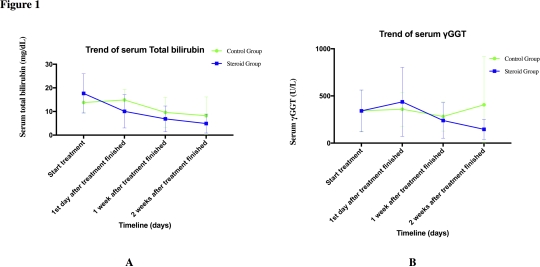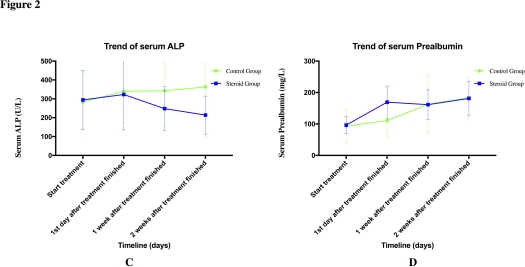The Efficacy of Low Dose Steroid Therapy for Postoperative Hyperbilirubinemia in Liver Transplant Recipients: A Prospective Randomized Controlled Trial
Organ Transplant Center, The First Affiliated Hospital of Sun Yat-sen University, Guangzhou, China.
Meeting: 2018 American Transplant Congress
Abstract number: C211
Keywords: Graft function
Session Information
Session Name: Poster Session C: Liver: Immunosuppression and Rejection
Session Type: Poster Session
Date: Monday, June 4, 2018
Session Time: 6:00pm-7:00pm
 Presentation Time: 6:00pm-7:00pm
Presentation Time: 6:00pm-7:00pm
Location: Hall 4EF
Background: Hyperbilirubinemia is a common but reversible event after liver transplantation . Steroids is a widely used anti-inflammatory agent, which may help improve allograft function, but limited study analysis the effect of steroid in post-transplantation hyperbilirubinemia. The aim of the study was to evaluate whether steroid therapy was benefit to hyperbilirubinemia. Methods: In our center, immunosuppression therapy adopted tacrolimus with basiliximab induction and steroids avoidance protocols. Postoperative hyperbilirubinemia patients (excluded biliary and vascular complications, rejections, etc.) were randomly assigned to steroid or control group. Patients in steroid group were treated by 1 mg/kg of methylprednisolone for 5 days combined with ursodeoxycholic acid (UDCA), the control group were only treated by UDCA. The primary end point was the trajectories of serum total bilirubin (TBIL) within the first two week after assignment. Results: Steroid group included 20 recipients, 10 in the control group. The data of donors, recipients and operation were not different between two groups. After 5-days treatment, mean TBIL levels decreased from 17.7 ± 8.3 mg/L to 10.1 ± 7.0 mg/L, however, TBIL increased from 13.8 ± 4.1 mg/L to 14.9 ± 4.4 mg/L in the control group ( and
and  ), which showed a significant difference on the trend of TBIL (decreased 7.6 ± 8.7 mg/L vs. increased 1.1 ± 4.2 mg/L, respectively, P=0.006). Moreover, after 5-days treatment the increase of prealbumin in steroid group significantly faster than the control group(73.0 ± 46.3 vs. 17.3 ± 42.0 mg/L, respectively, P=0.003).Neither serious infection nor ulcer were found during steroid treatment. Conclusions:Low dose steroid therapy may accelerate the recovery of hyperbilirubinemia in liver transplantation.
), which showed a significant difference on the trend of TBIL (decreased 7.6 ± 8.7 mg/L vs. increased 1.1 ± 4.2 mg/L, respectively, P=0.006). Moreover, after 5-days treatment the increase of prealbumin in steroid group significantly faster than the control group(73.0 ± 46.3 vs. 17.3 ± 42.0 mg/L, respectively, P=0.003).Neither serious infection nor ulcer were found during steroid treatment. Conclusions:Low dose steroid therapy may accelerate the recovery of hyperbilirubinemia in liver transplantation.
CITATION INFORMATION: Yang J., He X., Wu L., Guo Z. The Efficacy of Low Dose Steroid Therapy for Postoperative Hyperbilirubinemia in Liver Transplant Recipients: A Prospective Randomized Controlled Trial Am J Transplant. 2017;17 (suppl 3).
To cite this abstract in AMA style:
Yang J, He X, Wu L, Guo Z. The Efficacy of Low Dose Steroid Therapy for Postoperative Hyperbilirubinemia in Liver Transplant Recipients: A Prospective Randomized Controlled Trial [abstract]. https://atcmeetingabstracts.com/abstract/the-efficacy-of-low-dose-steroid-therapy-for-postoperative-hyperbilirubinemia-in-liver-transplant-recipients-a-prospective-randomized-controlled-trial/. Accessed December 14, 2025.« Back to 2018 American Transplant Congress
